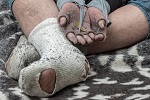
In war, fighting is just one of many ways soldiers suffer. They also endure disease and during World War I, a third of troops suffered from Trench Fever. It's rare to find cases today except in the homeless where it's increasing with the growing population.
Medical officers during World War I noticed soldiers complaining of headache, dizziness, and severe pain in the lower back, legs, and shins. It was eventually named Trench fever in 1916 for the soldiers in trenches who were getting sick. But they didn't know its cause. One captain guessed the body louse was to blame since fever was common in the winter months when flies and mosquitos were rare.
In 1917, a committee set up in France to study Trench Fever concluded the louse feces is how the disease spread. A year later, scientists identified the culprit, the bacterium Bartonella quintana.
Fast forward a century and in 2019 the number of homeless jumped by 3 percent, the third straight year of growth. Up to 30 percent of homeless people are infected with Trench fever.
The bacterium lives in the louse intestine and the insect's feces infect people through breaks in the skin. Fever begins about two to three weeks later and can recur every four to six days until it becomes less severe. But some infections can last up to eight years and develop into a fatal inflammation of the heart lining. To help the homeless avoid this kind of suffering they need better living conditions and support.
More Information
Today's Homeless Are Getting 'Trench Fever,' Infamous from WW I
A potentially deadly condition that plagued soldiers in the First World War is showing up in homeless people, Canadian researchers report...
Bartonella quintana and Urban Trench Fever
Contemporary Bartonella quintana infections have emerged in diverse regions of the world, predominantly involving socially disadvantaged persons. Available data suggest that the human body louse Pediculus humanus is the vector for transmission of B. quintana...
Trench Fever in the First World War
In mid-1915 physicians in the British Expeditionary Force on the Western Front in France began to notice an unusual acute febrile illness in soldiers accompanied by headache, dizziness, back ache, and a peculiar pain and stiffness in the legs, particularly the shins. Within a few months hundreds of cases had been identified clinically and, to great disappointment, laboratory studies had been unable to identify a cause. Early on, highest on the list of possibilities was a kind of enteric fever, thus, a new relative of typhoid fever. The soldiers, with rare insight, began calling it "trench fever" and their superiors eventually followed suit in the summer of 1916...